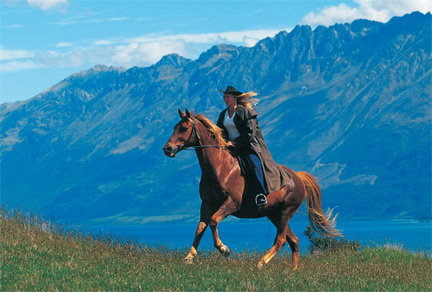How to Develop All the Essential Muscles Needed for Horse Riding
By Fred Goodson on Mar 10, 2010 with Comments 0
The most common misconception about riding is that “you just sit there,” and watching top riders competing on television does nothing to dispel this myth. A professional rider who has spent many hours practicing with their horse will have developed all the essential muscles needed for riding, and will demonstrate such a close partnership with their mount that they appear to communicate through their minds rather than their bodies.
Many people are surprised at how physical riding actually is, especially during trot and canter work. The addition of nerves can leave riders feeling even more breathless, particularly when beginning to jump fences. Learning to ride is a gradual process and, if taken at the right pace, the body adapts positively to the demands being made of it. However, there are various exercises that can be carried out that will make the experience much easier.

Cardiovascular fitness
Increasing general aerobic fitness will improve your athleticism and prevent you from tiring so quickly. Exercises such as swimming, cycling and jogging are all useful in building up stamina. Start by introducing at least one of these workouts for half an hour once a week, gradually building up to three half-hour sessions a week over time. This will greatly help to improve your fitness and make you feel much more comfortable during and after riding.
Suppleness and lower-back strength
Lower-back strength is vital. Much of the subtle control seen in advanced riders takes place in this area, so increasing core body strength is of great benefit. Classes in Pilates and yoga are excellent preparation for riding as they stretch muscles and build strength throughout the whole body without adding bulk. In addition, they encourage suppleness in the hip, knee and ankle joints, which aids stability on the horse and improves the shock absorption necessary for jumping. Because supple joints and good upper-body posture are so important, many riders study the Alexander technique. This helps them to sit correctly and dispels postural bad habits that can haunt some established riders for years.
Mental strength
Another important factor in rider fitness is the mental strength required to cope with riding large horses often in stressful situations, such as at competitions or in busy traffic. Horses are enormously sensitive creatures and respond to every tiny movement and emotional reaction produced by their rider. This can work against us when we are nervous but it is also why eventually we are able to ride without seeming to move. Learning relaxation skills and generally building up confidence around different horses will go a long way toward establishing your mental fitness and will continue to make riding a real pleasure.
Filed Under: Pets & Animals
About the Author: Fred Goodson has a passion for pets and animals. He has 4 dogs and is planning to have another one. He is also a blogger who writes about pets and animals. Currently, he is living in New Jersey.